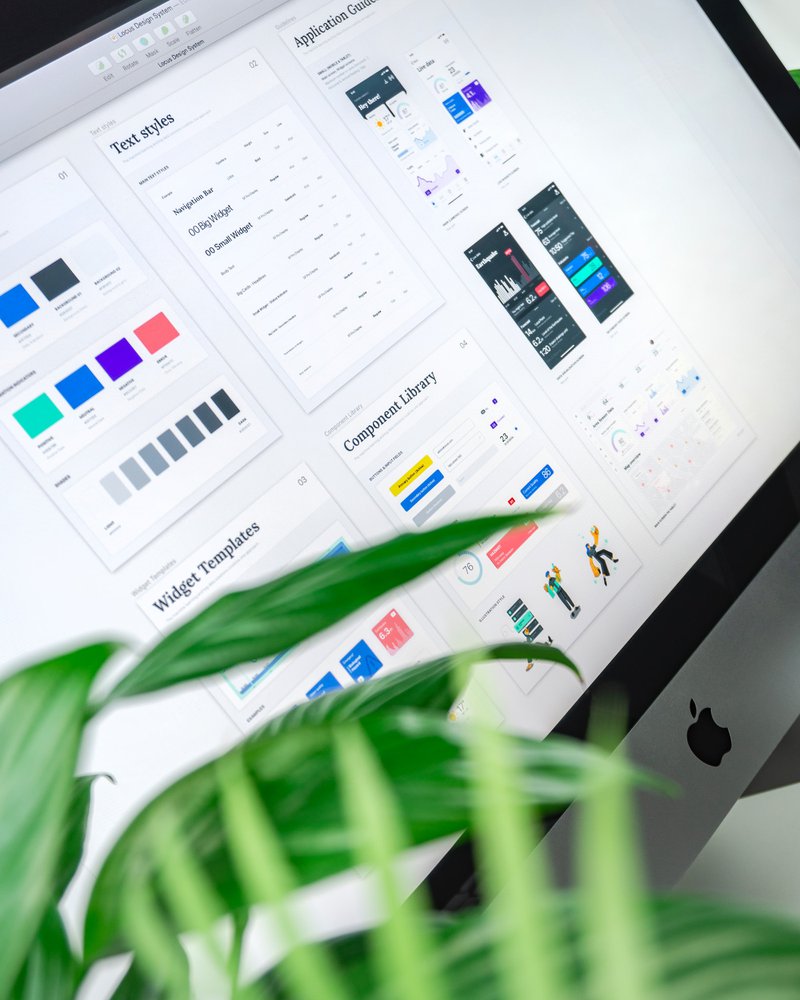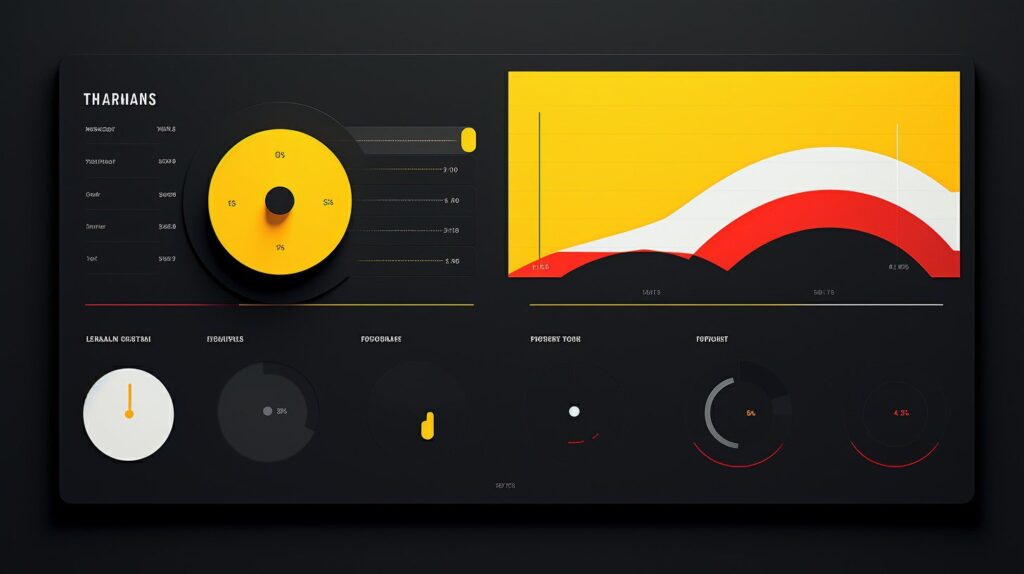The design system enables a team to build a product and digital experience that feels consistent across the brand. Half of all design professionals say their firm has developed design systems. They can increase consistency in the web development process — but only when teams understand the importance of what it does — and how designers built it.
Design systems are living, breathing entities that must be maintained and updated over time. Product teams should treat them as a single source of truth, allowing them to design and develop products.

What is a design system?
It is a constantly expanding set of reusable components, principles, and guidelines, giving designers, developers, and engineers a common design language for consistent product design and web development. People sometimes confuse design systems with patterns and style guides. This element is certainly important in overarching systems. But they are simply — defining elements for stronger wholes. Developing a digital product is a solution for designing user experience and digital products.
A style guide is a document that defines the voice, grammar, and look of a brand. On the other hand, a pattern library is a collection of interface elements that can be reused across projects. A design system is all of these things and more. It’s a foundation for product design and development. It includes not only reusable UI components but also the underlying principles, best practices, and documentation that guide a team in creating cohesive digital experiences.
Design systems have been around for a long time. But they’ve only recently gained popularity in the design community. One of the earliest examples of a design system is IBM’s Common UI Guidelines from 1992. More recently, companies like Google, Airbnb, and Shopify have all open-sourced their systems. Additionally, you can also see Salesforce’s Lightning Design System put the company’s design principles front and center.
A brief history of design systems
While designers have a moment of sunshine and everyone seems to be launching new designs, this isn’t a new idea at all. Andrew Couldwell, a graphic designer whose book is on design systems explains that design systems don’t exist anymore. Shawn Cheris, the Adobe Experience Development team leader, echoes this opinion. “We know Adobe for its wide range of product lines and its branding team has always been focusing on visual and architecture. We started talking about design systems about 10 years ago. At that time, we didn’t have a lot of formal processes or adoption around the idea.”
However, the real game-changer has been the rise of DesignOps. This relatively new field is responsible for coordinating and optimizing the design process within an organization. “DesignOps is critical for us because we now have so many moving parts. We need to make sure that the teams work efficiently and that they have the right tools and processes in place.”
Cheris believes that the biggest challenge for DesignOps is to get team members on board with the idea of a design system. There is still a lot of resistance to change, especially when it comes to something as fundamental as the way we design products.”

The importance of design systems
They are important because they help to create uniformity across products and platforms. They also make it easier for designers and developers to work together by providing a shared language and set of tools.
Another big benefit of design systems is that they can help to speed up the design process. This is because product teams don’t need to start from scratch every time they create a new product, feature, or material design. Instead, they can simply reuse the components that have already been created.
Designers can store all of the design elements in one place and can be easily updated if necessary. As a result, design systems can also help to improve the quality of products by making it easier to catch and fix errors.
Finally, design systems can help to create a better UX by making it easier for teams to find the information they need. This is because all of the products that use the system will have a similar look and feel.
Types of Design Systems
There are three main types of design systems: visual, interaction, and code.
Visual design systems include color palettes, typography scales, and iconography. On the other hand, interaction design systems define the way that teams interact with the product. Examples are button styles and form fields. Code-based design systems are modules of code that designers can reuse in different products.
Best practices when building your design system:
Define the scope of your design system
The first step is to understand the different types of products and digital experiences that your team will be building. This will help you determine the scope of your design system. Do you need to support a design language? Are there regional differences that need to be taken into account? What platforms will you be targeting?
Assemble a team
The next step is to assemble a design team of designers, engineers, and other developers who will be responsible for building and maintaining the design system. It’s important to have a diverse group of people with different backgrounds and perspectives on the teams.

Choose a platform
Designers can use many different platforms to build a design system. The most important thing is to choose one that will be easy to use and maintain. Some popular options include React, Vue, Angular, and Node.js.
Define the structure of your design system
The next step is to illustrate the structure of your design system with clear guidelines. Choosing a naming convention and deciding on the organization of your components and patterns is an example.
Build your design system
The next step is to build your design system. Examples are creating the individual components, writing documentation, and setting up a continuous integration and delivery pipeline.
Launch your design system
Once your design system is complete, it’s time to launch it to the world. Examples include announcing it to your teams, publishing it on your website, and distributing it through various channels.
Iterate and improve
The final step is to iterate and improve your design system. For example, collecting feedback, doing research, and adding new features over time.
Common problems when building a design system
These are the common things companies miss out on when building a design system:
Not Defining the Scope
The first mistake is not taking the time to define the scope of what the system will include. Trying to do too much can lead to a system that is difficult to use and maintain. It’s important to start small and then expand the scope as needed.
Not Assembling the Right Team
The second mistake is not assembling the right design teams. It’s important to have a diverse group of people with different backgrounds and perspectives. Without this, it can be difficult to build a system that meets the needs of all team members.

Not Choosing the Right Platform
The third mistake is not choosing the right platform. Many different platforms can be used to build a system. But the most important thing is to choose one that will be easy to use and maintain.
Not Defining the Structure
The fourth mistake is not taking the time to illustrate the structure of the design system. Choosing a naming convention, deciding on the organization of your component, and establishing guidelines should be done properly. Without a well-defined structure, the system will be confusing and difficult to use.
Not Building for Iterations
The fifth mistake is not building the design system for iterations. It’s important to launch the design system with a plan for how it will be improved over time. Designers and developers should include design elements that are easily improved through research of new design and development.
Building a system should only be the starting point. So it is important to create a system that is easy for the teams to work with. And it should also be easily improved in the future.
Challenges with Building a Design System Projects
Lack of executive support
The first challenge is the lack of executive support. Without buy-in from upper management, it can be difficult to get the resources needed to build a design system.

Lack of ownership
The second challenge is a lack of ownership. It’s essential to have someone responsible for maintaining the design system. That person would be responsible for making the design decisions to improve the system. Without this, the system can quickly become out of date.
Lack of documentation
The third challenge is a lack of documentation. It’s important to have clear and concise documentation for each component in the system. Without this, it can be difficult to use the system.
Lack of governance
The fourth challenge is a lack of governance. It’s important to have a process in place for approving changes to the design system. Without this, it can be difficult to keep the existing system consistent.
Lack of tools and resources
The fifth challenge is a lack of tools and resources. Many design systems require custom tools to build and maintain. Without these tools, it can be difficult to use the system.
These are some of the common challenges that lead many design system projects to fail. Without proper planning and execution, it can be difficult to build a successful design system.
When to Use a Design System?
1. There is a Need for Consistency. A design system can be a good solution if there is a need for uniformity across multiple products or platforms.
2. Need for Efficiency. Because design systems can automate repetitive tasks and help designers work faster, they provide a system at an efficient scale.
3. When There is a Need for Quality. Design systems can help ensure that products are designed and developed to a high standard because developers and designers will have clear guidelines of a design language to follow in creating a product.

What are the UI elements when creating a design system?
Component Library
A component library is a single file or folder consisting of styles and components used in a website, software, or app, including buttons, input fields, a UI kit, web design, and more. It is responsive (for web), flexible and scalable.
Style Guide
A style guide is a “subclass” in an overarching design system. It is a set of branding design principles that guide how products should be. Examples are the look and feel of the product, details about typography, use cases for UI patterns, and more. It’s the most accessible form of a set of design guidelines for a company.
Pattern Library
A pattern library is usually the heart of a typical design system. Pattern libraries are well-organized sets of reusable functional design components. Pattern libraries define the UI components of your products, how they behave, and how they should be used or implemented in your digital product.
Illustrations
An illustration system is a standard that a company, business, or individual uses to build and adapt a visual design. Brand designer Adam Ho describes an illustration system as, “a set of guidelines that enable the creation of artwork in a certain style.

Icons
Icons are graphic symbols that represent a concept or idea. They are representations of commands, devices, directories, or patterns. They should be used purposefully to maximize comprehension and reduce cognitive load when you need to call attention to a particular language, command, or section.
Typography
Typography is an important part of a design system that brings consistency across experiences and platforms. Good typography rules help present content clearly and efficiently.
User Flow Diagrams
User flows, UX flows, or flowcharts, sometimes called diagrams that display the complete path a user takes when using a product. The user flow lays out the user’s movement through the product, mapping out every step he takes—from the starting point right through to the final interaction
Wireframes
Wireframes are simplified, low-fidelity designs used to plan a product’s layout. It is a layout of a web page that demonstrates what UI elements will exist on key pages.
Mockups
Mockups are high-fidelity designs used to evaluate a product’s look and feel. They’re a visual representation or screenshot of how the final website or product will look.
Prototypes
Prototypes are interactive mockups used to test a product’s usability. Prototyping is an experimental process where design teams implement ideas into tangible forms, from paper to digital. Teams build prototypes of varying degrees of fidelity to capture design concepts and test them on users. You can refine and validate your designs with prototypes so your brand can release the right products.
What are the 10 main design principles?
Balance
Balance is the distribution of visual weight within a design. It refers to the way elements are arranged so that their visual weight harmonizes with the other elements in the design, and the composition gives an appearance of properly distributed elements.
Contrast
Contrast is the difference in visual properties between two elements. It is a crucial aspect of visual hierarchy and an essential element in graphic design. It is a wonderful technique to draw the viewer’s attention while also organizing the elements in your graphic design by concentrating the eye on the most significant areas of it.

Emphasis
Emphasis is the focus of attention within a design. It is a strategy that aims to draw the viewer’s attention to a specific design element. That could be an area of content, an image, a link, a button, or patterns. We see emphasis used in most fields of design, including architecture, landscape design, and fashion design.
Hierarchy
Hierarchy is the arrangement of elements in a design from most important to least important. By laying out elements logically and strategically, designers influence users’ perceptions and guide them to desired actions.
Proportion
Proportion is the relationship between the size of an element and the size of the whole design. It refers to the relationship between one part of a design and another part or the whole design. It is a comparison of sizes, shapes, and quantities.
Repetition
Repetition is simply repeating a single element many times in a design. For example, you could draw a line horizontally and then draw several others next to it. Repetition can be useful in web and app design. For example, you’d expect the logo of a business to be repeated on every page and in the same place.
Rhythm
Rhythm in design refers to interval-repeating elements. An agreed element’s location creates a sound structure. Rhythm can unite, direct, highlight, and set the dynamics. There is a repetition of shape, color, tone, texture, accents, direction, and dynamics. Rhythm organizes, structures, and set the elements into motion.
Space
Space is the area between and around elements in a design. Spaces are the horizontal and vertical distances between two components or the viewpoints of the screen. All spaces are set to an increment of 8 (8, 16, 24, 32, 40, 48, … 128).
Unity
Unity is the feeling of harmony within a design. It is the principle of design that unifies all other principles within a piece of work, allowing each element to coexist with one another to form an aesthetically pleasing design.
Variety
Variety is the use of different elements within a design. It refers to how artists and designers add complexity to their work using visual elements. Contrast, difference and change, and elaboration all add visual interest to an artist’s work.
How do I start designing a design system?
There are many ways to start designing a design system. One way is to begin by creating component libraries. This can be done by starting with a small set of common components and then expanding it over time. Another way is to start with a style guide. This can be used to define the standards for the design and implementation of the product. Additionally, a pattern library can be created. This can be used to collect and document reusable design patterns. Finally, UX flow diagrams can be created. These can be used to visualize the user’s journey through the product.
What is a design guide?
A design guide is a set of guidelines and design principles for the implementation of a product. It helps to ensure that the product is consistent with the brand, efficient, and of high quality. Additionally, a design guide can help to automate repetitive tasks and speed up the design process.

Where do I hire a designer to create a design system?
There are many ways to find designers to create a design system. One way is to post a job on a job board such as Upwork or Freelancer. Another way is to use a platform such as 99designs. Or, you can use a service such as Fiverr. But the best way to hire a designer is through a direct match with Design Match.
Design Match is the best way to hire a designer because we pre-screen all our designers. This means you can be sure you’re only presented with qualified candidates. In addition, we do not ask for payment until you decide to start working with your designer.
You can also hire a UX designer at Design Match to help you create minimum viable products or UX flow diagrams for your company. You can choose from our pool of qualified designers for whatever design needs your company requires.




